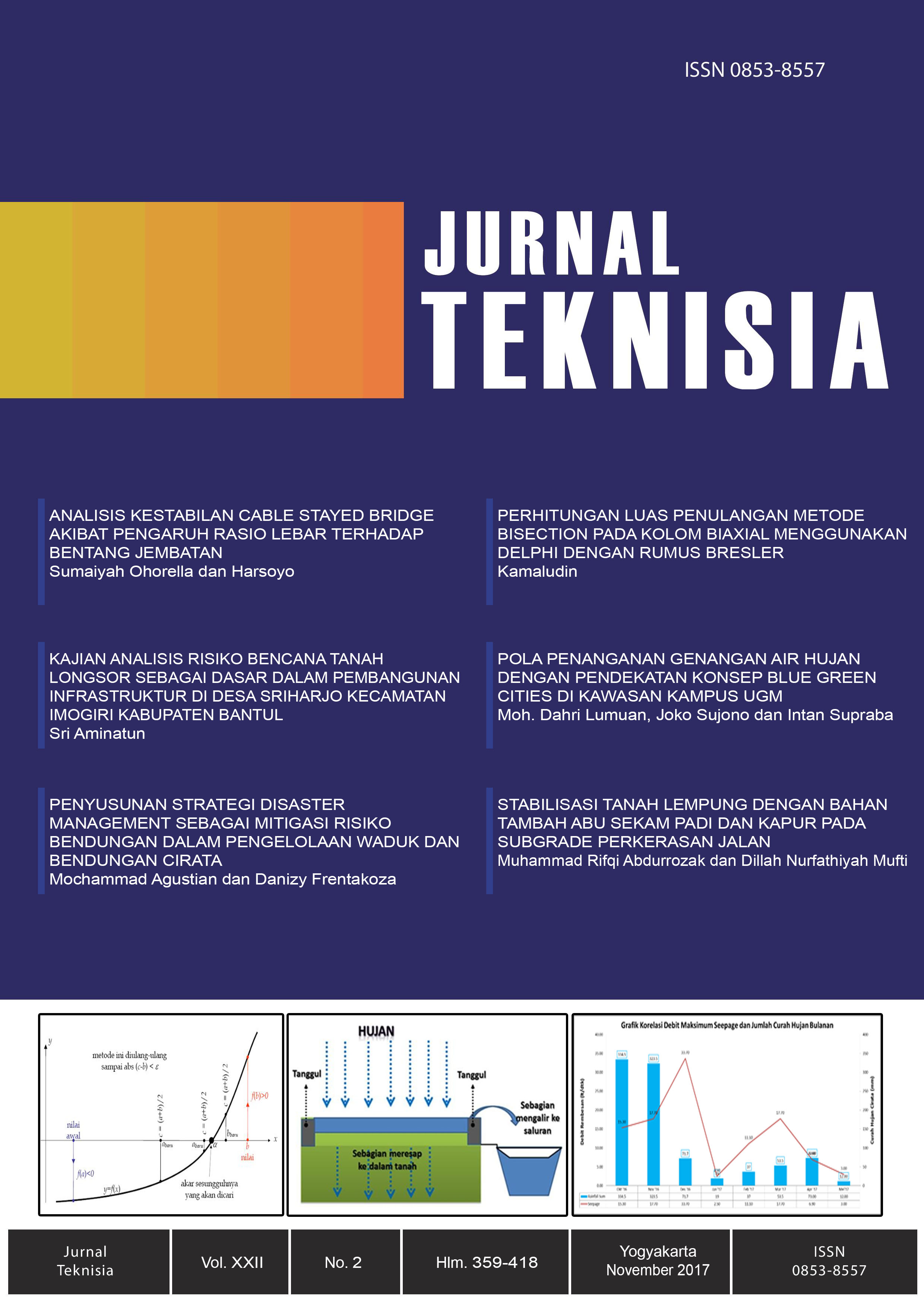Main Article Content
Abstract
Cable stayed is one of the long spans bridge structure that can minimize the use of pillars so that access under the bridge can be utilized optimally. The main structure of the cable stayed bridge is a cable connected from the bridge deck to the pylon. Problems in long spans bridge structure is wind can provide significant changes in the structure of the bridge. Based on previous experience and research, shows that the influence of wind can cause security and service problems. It can even cause instability in the entire bridge structure due to the flexible nature of its structure. This study aims to analyze the stability of the cable stayed bridge due to the influence of the span ratio to the width of the bridge. The width of the bridge is varied from 14 m to 24 m every 1 m addition modeled using the SAP2000 v.14 program. The object of research using Jembatan Merah Putih, Ambon. The structural response is observed as the natural vibration frequency, internal force and deformation of the structure. The larger the ratio of bridge width to the main span of the bridge, the greater the weight itself and the load of the service work on the bridge structure. So the values of the inner forces that are generated on the main structure include the tower and the bridge deck will be greater for each additional width of the bridge. For the bridge width ratio to bridge span of 0.093 to 0.133, the width of the bridge 14 m to 22 m remains stable against the aerodynamic effect due to wind according to Leondhart, B ≥ L / 30 and still qualifies the maximum deflection according to AASHTOÂ
(dmax= ð¿ð‘¡ð‘œð‘¡ð‘Žð‘™/800) and AISC (dmaks= ð¿/150).
Keywords
Article Details
Under the following term:
-
Attribution — You must give appropriate credit, provide a link to the license, and indicate if changes were made. You may do so in any reasonable manner, but not in any way that suggests the licensor endorses you or your use.
-
ShareAlike — If you remix, transform, or build upon the material, you must distribute your contributions under the same license as the original.
- No additional restrictions — You may not apply legal terms or technological measures that legally restrict others from doing anything the license permits.
References
- Algazt, M.A, 2015, Analisis Kestabilan Cable Stayed Bridge Tipe Sharp Akibat Rasio Bentang Terhadap Lebar Jembatan, Tugas Akhir, Universitas Gajah Mada, Yogyakarta.
- Badan Litbang PU Departemen Pekerjaan Umum, 2005, RSNI-T-02-2005, Standar Pembebanan untuk Jembatan, Penerbit Bina Marga, Jakarta.
- Badan Standarisasi Nasional, 2008, SNI 2833-2008, Standar Perencanaan Ketahanan Gempa Untuk Jembatan, BSN, Jakarta.
- Ilham, M Noer. 2011. Jenis Jembatan. http://mnoerilham.blogspo t.com/. Diakases pada Hari Sabtu, 22 Januari 2017, pukul 20.22 WIB. Podolny & Scalm J.B. 1976. Construction and Design of Cable Stayed Bridges. New York: John Wiley & Sons Inc.
- Roliansjah, S. & Zarkast I. 1995. Perkembangan Akhir Jembatan Cable Stayed. Makalah pada Konferensi Regional Teknik Jalan (KRTJ) IV, Padang.
- Sihisopi, Putri., 2017, Studi Perbandingan Studi Perbandingan Respon Struktur Pylon pada Jembatan Cable Stayed Tipe Fan dan Tipe Harp, Tugas Akhir (Tidak Diterbitkan), Universitas Islam Indonesia, Yogyakarta.
- Suangga, M. (2002). “Beban Dinamik Angin pada Jembatan Bentang Panjangâ€, Conference on Long Span Bridge, Tarumanegara University.
- Supriyadi dan Muntohar, 2007.JEMBATAN (Edisi Ke-IV), Beta Offset, Yogyakarta.
- Supriyadi, Bambang dan Muntohar, Agus S., 2007, Jembatan, Beta Offset, Yogyakarta.
- Troitsky, S. 1997. Cable Stayed Bridges Theory and Design. Callifornia: Crosby Lockwood Staples.
- Walther, R. 1988. Cable Stayed Bridges. London: Thomas Telford.
- Widodo. 2001. Respon Dinamik Struktur Elastik. Jurusan Teknik Sipil FTSP, Universitas Islam Indonesia. Yogyakarta.
- Widodo. 2012. Seismologi Teknik & Rekayasa Kegempaan. Yogyakarta: Pustaka Pelajar
References
Algazt, M.A, 2015, Analisis Kestabilan Cable Stayed Bridge Tipe Sharp Akibat Rasio Bentang Terhadap Lebar Jembatan, Tugas Akhir, Universitas Gajah Mada, Yogyakarta.
Badan Litbang PU Departemen Pekerjaan Umum, 2005, RSNI-T-02-2005, Standar Pembebanan untuk Jembatan, Penerbit Bina Marga, Jakarta.
Badan Standarisasi Nasional, 2008, SNI 2833-2008, Standar Perencanaan Ketahanan Gempa Untuk Jembatan, BSN, Jakarta.
Ilham, M Noer. 2011. Jenis Jembatan. http://mnoerilham.blogspo t.com/. Diakases pada Hari Sabtu, 22 Januari 2017, pukul 20.22 WIB. Podolny & Scalm J.B. 1976. Construction and Design of Cable Stayed Bridges. New York: John Wiley & Sons Inc.
Roliansjah, S. & Zarkast I. 1995. Perkembangan Akhir Jembatan Cable Stayed. Makalah pada Konferensi Regional Teknik Jalan (KRTJ) IV, Padang.
Sihisopi, Putri., 2017, Studi Perbandingan Studi Perbandingan Respon Struktur Pylon pada Jembatan Cable Stayed Tipe Fan dan Tipe Harp, Tugas Akhir (Tidak Diterbitkan), Universitas Islam Indonesia, Yogyakarta.
Suangga, M. (2002). “Beban Dinamik Angin pada Jembatan Bentang Panjangâ€, Conference on Long Span Bridge, Tarumanegara University.
Supriyadi dan Muntohar, 2007.JEMBATAN (Edisi Ke-IV), Beta Offset, Yogyakarta.
Supriyadi, Bambang dan Muntohar, Agus S., 2007, Jembatan, Beta Offset, Yogyakarta.
Troitsky, S. 1997. Cable Stayed Bridges Theory and Design. Callifornia: Crosby Lockwood Staples.
Walther, R. 1988. Cable Stayed Bridges. London: Thomas Telford.
Widodo. 2001. Respon Dinamik Struktur Elastik. Jurusan Teknik Sipil FTSP, Universitas Islam Indonesia. Yogyakarta.
Widodo. 2012. Seismologi Teknik & Rekayasa Kegempaan. Yogyakarta: Pustaka Pelajar
